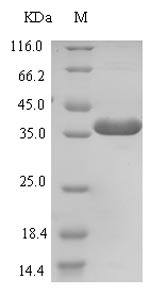The synthesis of this Recombinant Human ZNRF3 protein depends on the utilization of recombinant DNA technology. DNA sequences that encoded the ZNRF3 protein could be inserted into a vector and introduced into an expression host, E.coli, where it could be easily expressed in and purified from. The expression of this ZNRF3 protein was at 56-219aa. N-terminal 6xHis-SUMO tag was fused with this protein. The purity is 90%+ determined by SDS-PAGE.
ZNRF3 (also known as KIAA1133 or RNF203) is gene encoding a protein named E3 ubiquitin-protein ligase ZNRF3 (ZNRF3) in human. The protein encoded by this gene is also known as RING finger protein 203, RING-type E3 ubiquitin transferase ZNRF3 or Zinc/RING finger protein 3. Emerging evidence has implied that ZNRF3 is associated with the Wnt receptor complex, and inhibits Wnt signalling by promoting the turnover of frizzled and LRP6. The protein encoded by ZNRF3 gene is an enzyme that has ubiquitin protein ligase and ubiquitin-protein transferase activity. It is involved many biological processes, including limb development, negative regulation of Wnt signaling pathway, stem cell proliferation and protein ubiquitination.






